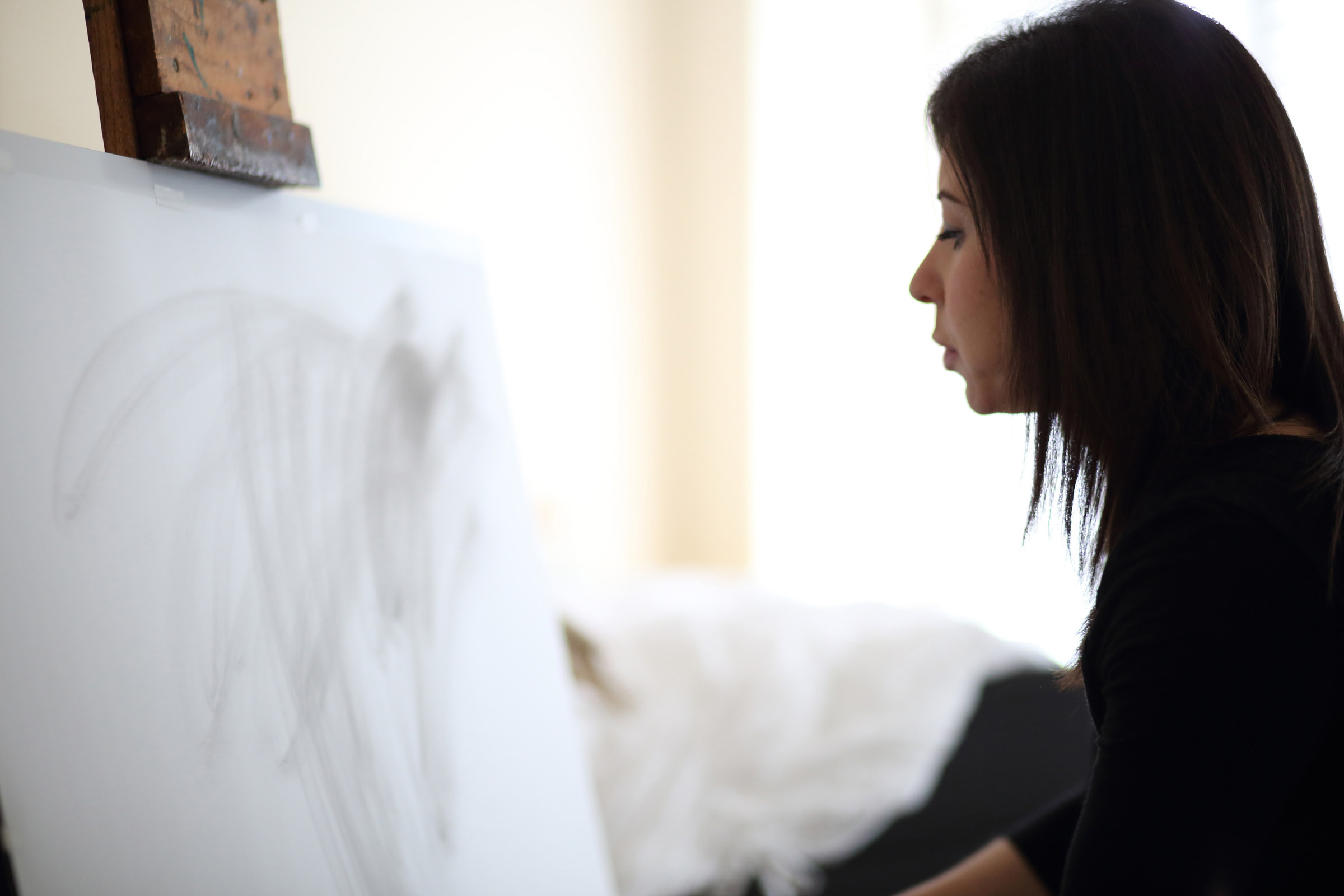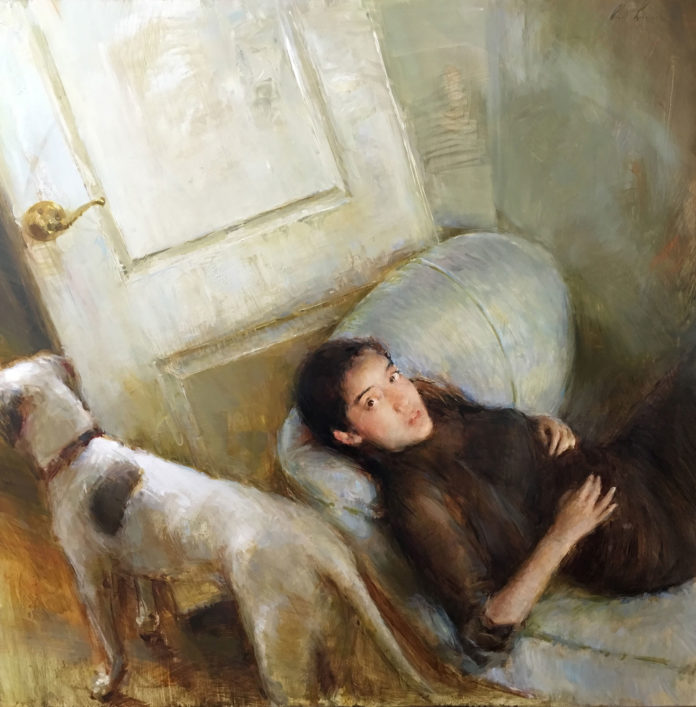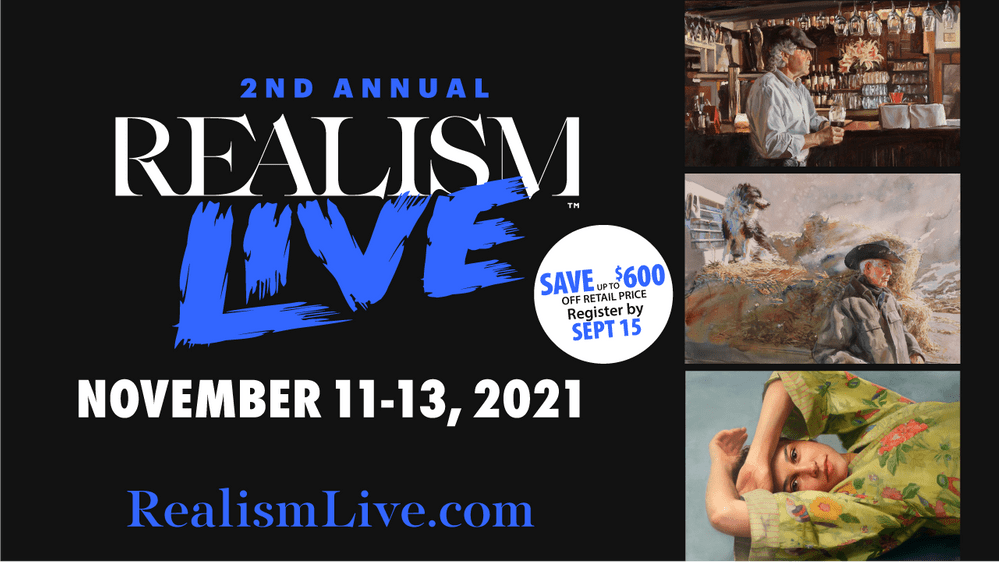Use strong diagonals and curves to create a unique painting composition. Olga Krimon explains.
Approaching Composition
BY OLGA KRIMON

A painting is a carefully orchestrated reality. It draws us in, and keeps us in. It moves our eyes in a certain way through it. It’s a world constructed by the artist with a vision, an idea of how to create and control the movement within it, to make it breathe. That’s what I am striving to achieve, and I will explain my thought process below using some of my earlier paintings.
As an academic art student back in Russia, I carefully drew from plaster casts, studying and meticulously copying, gradually building skills and confidence, training the hand and the eye. I got so used to copying what I saw. If there was a drape behind the model — you bet it would make it into those early works, regardless of its real purpose within the painting composition.
But then something started to happen. I tried to get the essential information and combine (or create) imagined elements to generate a flow within a piece. Strong diagonals and curves entered my works and have been there ever since. Shapes started to dance and take spaces that I felt they had to take. It was as if some voices in my head were talking — “continue this line through the model’s arm and add a fold, or change the direction of the stroke so that the eye of the viewer will follow it. Lead them to this light, then abruptly turn through this curve. There is no table here but you really need one, and it has to have this specific curve and the books on it have to be arranged so that the lines parallel those of the folds.” I started to build my own reality, rather than copying what I saw.
Every artist has his or her own way of composing. I am aiming to create a certain movement within my works using strong diagonals, parallel lines, repeated shapes, experiments with perspective and so on when creating a painting composition. I am fascinated with what these elements can do. I am fascinated with how much power an artist has in making the eyes of the viewer travel in a certain logical way (without the viewer realizing that he or she is being lead). Here is a reconstruction of my initial thought process when I created “Birthday Cake.”

My painting “Birthday Cake” started as a curve that eventually became an edge of a drape (downward diagonal). It pushes up through the shirt and the head of the model, curves around it and drops sharply down through the hair. This strong dark vertical is repeated by the light vertical shape of the lit-up arm. The other arm forms a diagonal that repeats the initial diagonal of the drape, with the mirrored diagonal of the pillow. It’s this up and down, up and down that I wanted to have.
I didn’t see this painting composition, it never existed. I created it to achieve this movement. The round table evolved later, both to repeat the curves of the other elements in the composition and to make the viewer’s eye stay in and go around it over and over. This arrangement created a mood that I strived to achieve. The model was needed to materialize what I already had in my head. I didn’t know that I would have a drape, but I knew I needed a diagonal. I could’ve created it by other means — in fact, it didn’t matter what it would be, but I knew it had to be a diagonal, separating the light from the dark, and the one that will need to be repeated and mirrored somewhere in the painting.
This diagonal doesn’t end with the drape touching the table. It continues through the table (there is a reason why the end of the cake is where it is), and through the seated model’s back, and through her hand pushing into the bed. And the drapes of the bedsheet are created to further continue this line.
Diagonals are also repeated through a chair, the side of the bed, one of the napkins, fingers, the arm in the shadow, and the strands of the model’s hair. They are even repeated in the chipped paint of the wall. They are counterbalanced by the opposite diagonals of the shadows, the pillow, the draping of the short and the long strands of hair falling on her hand. And the verticals — the arm in the light, the patterns on the wall, the hair in the shadow, the candles, the bottle.
Many of these elements are completely imagined (in fact, all I had was the model positioned on the bed). It’s a game of balance and counterbalance, and with that I felt that the girl had to be off-center. Her silhouette is counterbalanced by the shape of light from the window on the left. Removing that element, in fact removing any of these relationships would alter and skew the harmony that I was trying to create. Carefully designed repetitions create a certain movement within a painting. This all started with the diagonals and curves in a sketchbook. Everything else grew slowly around it.
Related article > Painting Composition 101: Tips From Huihan Liu

“Ania” is an example of my earlier work (2014), and it’s interesting to compare it to “Birthday Cake.” It’s also a girl with a curved table, yet again it didn’t start with the model. It started with the table, and I wanted the curve of the table repeated in the model’s shape. The girl morphs around the table, her curves in unison with the main curve of the table edge. With that in mind for the painting composition, I needed to see more of the table, so my eye level is much higher here.
It was a feast of diagonals for me (although it wasn’t much fun for Ania, as this was not the most comfortable pose). The books are selected and positioned in a logical manner. Let’s follow the diagonal of the brown book from left to right, one edge of it continuing through the girl’s shoulders, another through the cup, the breast, the elbow.
The red diagonal of another book is aimed at her shoulder and amplifies the perspective effect (the diagonal of the brown book and the red diagonals meet at the shoulder). The eye then travels down the arm, through the fingers, with the hand following the curves established by the table, and the thumb forming a diagonal (again) followed through the edge of the black sketchbook. The little black book parallels the shoulder and breast lines.
I used strong verticals of the candles with a curved candlestick to repeat the curves of the other elements. It is similar to the shape of the head, and this push and pull between the candlestick and the head is intentional.

Another example is the painting “Guard” (also shown at top) that was created last year. In this example, I purposefully distorted perspective to create the effect of falling into this space. Low diagonals through the back of the dog and the positioned figure are further amplified by the strong diagonals of the door edges. Yet the opposing diagonals of the indentations in the door pull us in the opposite direction, and so does the chair, and so does the arm. Remove them, and everything falls apart, leaning desperately to the left.
I wanted the eyes of the viewer to travel through the arm, the dog’s back, the door pattern, then again down through the curve of the chair and the soft shadows on the wall, leading to the place where we started — and again, and again.
I am intentionally using my works from different time periods and series to illustrate my painting composition thoughts. My paintings evolve, but my passion for creating movement in them through the use of diagonals and curves is consistent over the years.

“Silence” is one of my favorite pieces. The abstracted shapes of the shadows dance and move in perspective forming diagonals that are opposed to the heavy diagonals of the bench. Just like with “Birthday Cake,” the figure is again off-center. But the heavy weight of the bench counterbalances this intentional displacement.
The girl is in her own world, everything around her pulsates and dances. Yet she is quiet, static, turned away, private. But she also morphs into this calculated chaos, her shirt becomes one with the bench in the shadow. I feel that I would’ve not expressed this idea in any other way than through this use of amplified diagonals. If I positioned her in the center, with the realistic tree shadows of the actual landscape — imagine that effect. It would ruin the painting idea for me.

The same composing ideas are true for drawings. This drawing Yin and Yang from 2016 is an example of curve-on-curve. The curve of the boy’s figure continues through the arm of the sofa, and is repeated almost exactly by the curve of the pillow and the dog’s head and ear. And the curve is repeated again by the dog’s leg, while the other paw continues through the arm of the boy.
I feel like I am traveling from lower left, up to the top middle, and back to the lower right, then horizontals bring me back to the lower left, and I repeat that same movement.
The diagonal of the boy’s body is repeated in the dog’s head as well. This was that lucky example of the models taking a great pose themselves. Models sometimes take the best poses when they are resting, and they may completely change what you had in mind. And accepting that may lead to new discoveries.
To this day, it’s composing a painting or a drawing that makes me so excited about creating a new piece. From having an idea, to actually developing the composition that materializes it — it’s such a rush. Artists have many means to play with in this journey. And we continue to experiment with them for the rest of our lives. 
ABOUT THE ARTIST
Born in Odessa, Ukraine, Olga Krimon received academic art education in Kazan, Russia. Growing up she was (and still is) largely influenced by Repin, Serov, Brullov, Levitan, Kramskoy, Fechin and other Russian titans. She then discovered Sargent, Zorn, Sorolla and Cecilia Beaux, and to this day she examines the movement, the bold brushstrokes and the value arrangements in their pieces.
She continued to grow and develop her skills later in America through drawing classes with Glen Orbik and painting classes with Jeremy Lipking. Olga also holds a BA in Art History, and she credits it with providing her the rich visual vocabulary that is instrumental for defining her path as an artist. She also later received an MBA, making her well-grounded in the business side of an artistic career.
Olga continues to refine her craft through independent studies and daily practice. Over time, she developed her own style grounded in fundamental principles of academic realism, sensitivity to subtle value and color transitions, and yet bold energy of movement and expressive brushstrokes. Olga’s Figurative and Still Life Paintings are recognized by the Portrait Society of America PSoA (International Competition 1st Place Drawing 2016 and 3rd Honor Award 2014, Certificates of Excellence 2011, 2015 and 2018, Members Only 3rd Merit 2015 and Honorable Mention 2014) and American Art Collector Award of Excellence, Oil Painters of America (OPA) Western Regional Competition 2014. She is also a finalist in 2015 and 2016 Art Renewal Center (ARC) International Salon Competition.
Visit EricRhoads.com (Publisher of Realism Today) to learn about opportunities for artists and art collectors, including:
- Art retreats
- International art trips
- Art conventions
- Art workshops (in person and online)
- And more!








thank you so much for this piece Olga. I just loved following your thought process in developing a composition. it all makes so much sense. my paintings, like yours in the beginning, are just copying what I see and I so want to move past that in creating interesting compositions. I have tried so hard to loosen my painting style to achieve the type of look you have but my analytic brain just has not allowed it. I’m hoping I can implement these lines and movements in my future paintings as well as loosen my approach which is so like.
Thank you for your comment, Paul. I feel that when I start with long purposeful lines and big shapes I achieve the balance in my compositions much more naturally than if I start with details (such as the face). And making thumbnail sketches, quite a few of them, trying to crop differently, trying to play with the diagonals. You are right, it’s a balance of analyzing vs letting go. Good luck with your search, and contact me directly with any questions. My contact information is on my website http://www.olgakrimon.com.
Comments are closed.